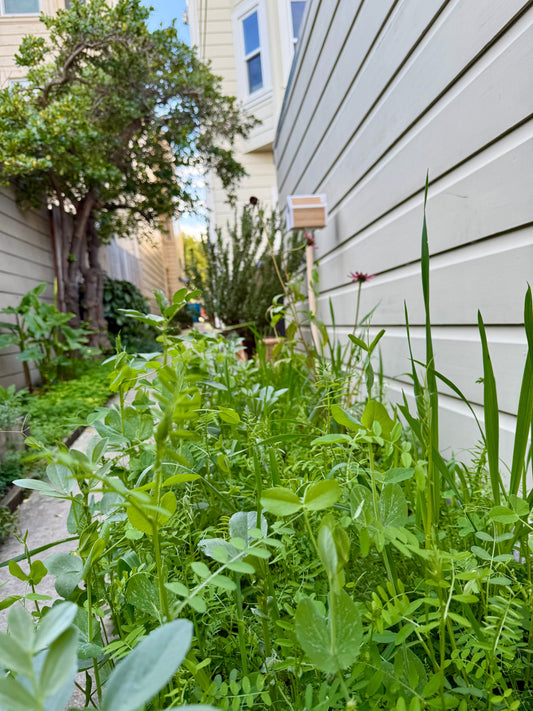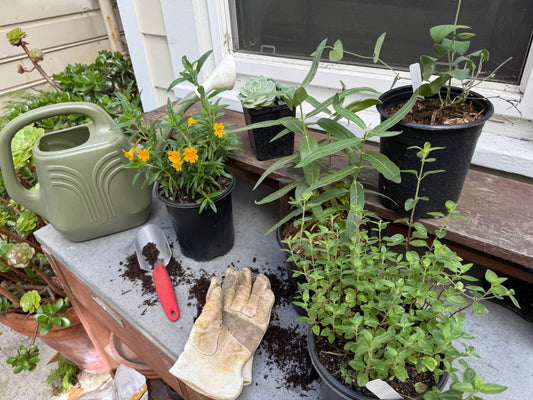I was out to dinner with friends the other night and they were asking about the new business.
Them: “What’s the name, again?”
Me: “The Quane Garden” (that’s Quane like Rain, not Quan like Lawn BTW)
Them: “Ahh…” (blank stares)
Working with one of my suppliers the next day, it took them four tries to get the name right to find me in their system.
I get it. The name is kinda weird. It’s hard to pronounce and doesn’t tell you much about the business it represents. From a branding and marketing perspective, it doesn’t do much heavy lifting in introducing your brand to others.
The short version of the story is that Quane is the name of the alley that runs behind our building. Just three blocks long, the alley provides backstage views of the grand facades of Dolores Street and Fair Oaks, revealing turn of the (20th) Century laundry porches and clothesline pulleys, a higgledy-piggledy assortment of former horse stables and carriage houses that now house Subarus and Teslas, and a rooftop beehive garden that's constantly abuzz. Quane Alley gives country lane vibes right in the heart of the busy city.

The Mission District’s alleys each have their own personality. Some are famous for their murals and the history they tell - Balmy Alley tells stories of human rights, political corruption, gentrification and injustice. Clarion Alley is like the front page of the paper - in mural form, reporting on the most pressing social issues of the moment. Ames Alley is pooch-playground where locals have a standing dog meet-up every evening and neighbors gather while kids ride bikes in the street. The Mission’s alleys are some of our under-appreciated Third Places, where neighbors connect and seek a quieter interface with one another and their city.


I’d like to see Quane Alley become The Garden Alley - telling the story of the flora and fauna that have called this place home for thousands of years, and serving as a refuge for the native pollinators and beneficial species that call this place home.
But that’s not why I named the garden after the alley.
It happened … organically, and it started with bees. A few doors down in the alley, there’s a towering collection of honeybee hives on the roof of an old garage surrounded by what can only be described as an epic wisteria. Robert, the beekeeper, is always more than happy to talk bees and what he's currently working on to keep his colonies healthy (when he’s not elbow-deep in bees). Robert’s bees come to my little garden to feed from my flowering plants. It was that connection to the honeybees down the alley that changed my perspective on what I was doing “out back.” I was no longer just trying to grow a decent tomato (MUCH more on that at a later date), I also wanted to fill the garden with an absolute smorgasbord of tasty treats for Robert’s bees. That little shift in focus -thanks to the alley- was what started me thinking about how my little patch of soil in a sea of concrete was connected to the larger web of life.

The garden is also so much more than just a garden.
Not only is it a way to spend time outdoors in the sunlight and fresh air while still being at home, I get to share what I grow with others. When Rosemarie, the rosemary bush needs a little coiffure, or it’s time to cut back the lavender, or if we have a particularly bumper crop of Sungolds, it feels so great to be able to share that bounty with neighbors who live in the building or stop by while walking their dogs in the alley. It’s great to have a strawberry patch right by the back gate, encouraging folks to pluck a ripe berry on their way home from work.


Gardening is also a connection to the past. The sound of a trowel slicing into the soil or the smell of the damp earth meeting my nostrils immediately reminds me of my childhood, when weekend days were nearly always spent by my mom’s side as she worked in the garden - kind of like that scene from Ratatouille where the grouchy food critic takes his first bite and is immediately whisked to his most-treasured childhood memories. My mom learned to garden from her mother, who presumably learned from her mother and so on. When I’m out working in the garden, practicing the lessons she taught me, I feel connected to an ages-long string of my ancestral mothers cultivating the earth to nurture those around them.
Woah, that just got heavy. But that’s kinda awesome too. Maybe gardening happens on a genetic level? Heck, just today my doctor was extolling the virtues of “touching dirt” to absorb its beneficial bacteria.
Working in the garden is also a meditation. Being present as both a participant and spectator to the continuation of life doing its thing as it has for thousands of years helps you regulate, reframe and reconnect. I do some of my best thinking out in the garden. When I get stuck on a task, or my brain just becomes a stubborn dog who digs in its heels and doesn’t want to take another step, I step out into the garden. Just five minutes of fresh air, dappled sunlight and the visual stimulation of a corpulent bumblebee covered in pollen doing a belly flop into a California Poppy provides an immediate attitude adjustment. It’s magic. Nature’s pharmacy.

The back gate, which opens onto Quane Alley has become this great interface with neighbors who constantly stop by to take a pause and enjoy the view or comment on the garden while I’m working. They tell me how their dogs insist on climbing the back steps to survey the garden through the gate, or how much they enjoy watching the vegetable garden grow throughout the seasons, or how the garden reminds them of memories they have of the smell of a tomato plant. For an introvert like me, the Garden is a great connector to my neighbors.
I’ve had so many people who stop by say they wish they could have a garden, but feel they don’t have the space or the talent. And the fact is, you can cultivate a beautiful garden almost anywhere. Whether it’s growing a tomato in a bag on your back stairs, hanging some flowerpots on your window ledge, building a terrarium out of an old mason jar, or, like me, thinking that area next to the garbage bins has some potential, you too can be a gardener. If you think you have a black thumb and are destined to fail - welcome to the fail party! Don’t get me started on my annual battle with Powdery Mildew (more on that later too).

Gardening in San Francisco’s unique climate (The Department of Public works identifies at least 26 unique microclimates in our wee 49 square mile footprint) and translating plants’ native environments to our urban context isn’t always straightforward. But the journey to understand it all and occasionally succeed is really fun.

And that brings us back to the name. After years of watching others peer in through the Quane Gate, I’ve decided to share my weird little journey online and invite anyone who’s interested to watch as I fumble my way through planty goodness and discovery.
I think this garden has a great story to tell, and I’m excited to share it with you.




